Introduction to Personalized Emails

What Are Personalized Emails
Personalized emails are crafted messages tailored to the individual recipient's preferences, behaviors, and interests, using data collected over time. This personal touch can significantly increase the recipient's experience by making the content more relevant and engaging.
- Customization: Personalized emails may include the recipient's name, personalized subject line, references to past purchases, or content based on browsing history.
- Relevance: They aim to deliver content that aligns with the recipient's interests or needs, increasing the likelihood of engagement.
Why Email Personalization is Important
Personalized email marketing has shown to significantly impact engagement, conversion rates, and customer loyalty.
Below are key statistics that highlight the effectiveness and importance of personalizing emails in marketing strategies:
1. Increased Open Rates
Emails with personalized subject lines have a 26% higher open rate compared to emails without personalization, according to a study by Campaign Monitor. This illustrates the immediate impact of personalization on recipient behavior.
2. Increase in Click-Through Rates (CTR)
Personalized emails enjoy 14% higher click-through rates than non-personalized emails, as reported by Mailchimp. This indicates that recipients are more likely to engage with content that feels relevant to them.
3. Improved Conversion Rates
According to Experian, emails with personalized content can see a sixfold increase in transaction rates. This is a clear demonstration of how effective personalization can be in moving recipients through the sales funnel.
4. Improved Customer Experience
74% of customers feel frustrated when website content is not personalized, per a Segment report. This frustration likely extends to email content, underscoring the importance of personalization in creating positive customer experiences.
5. Higher Revenue
Marketers see an average increase of 20% in sales when using personalized experiences, including email marketing, according to Monetate. This suggests that personalization not only enhances engagement but also directly contributes to revenue growth.
6. Preference for Personalization
91% of consumers are more likely to shop with brands that provide relevant offers and recommendations, as found in a study by Accenture. This preference for personalization extends to email marketing, where relevant, personalized emails are more likely to result in purchases.
7. Retention and Loyalty
A report by SmarterHQ highlighted that 72% of consumers in 2019 only engaged with marketing messages that were customized to their specific interests. This suggests that personalization is key not just for attracting customers, but also for retaining them.
How to Create Personalized Emails

Creating personalized emails involves more than just addressing a recipient by their first name; it’s about crafting messages that resonate personally with your audience.
This strategy has proven to significantly increase engagement and conversions, with emails that use personalization generating 50% higher open rates on average.
Here's a guide to developing personalized email campaigns that captivate and convert.
Understand Your Audience
Before diving into data collection, it's important to know what information will be most useful. This involves understanding the different facets of your audience, including their preferences, behaviors, and needs.
- Identify Key Data Points: Focus on collecting data that directly impacts email personalization. This includes demographics, purchase history, email interaction data, and browsing behavior.
- Set Clear Goals: Define what you aim to achieve with email personalization. Whether it's increasing open rates, enhancing click-through rates, or driving sales, your goals will guide the type of data you need to collect.
- Behavioral Triggers: Use customer actions, like browsing a specific product category, to trigger personalized emails. Studies show that triggered emails can increase click-through rates by over 200% compared to generic emails.
How to Gather Data for Email Personalization
Gathering data for personalized emails involves using various methods and tools to capture information about your subscribers. This data forms the foundation of your personalization strategy.
Email Sign-Up Forms: Use sign-up forms to collect basic information like name, email address, and preferences. Optimize your forms to include fields that are most relevant to your email personalization goals.

- This initial data collection point is crucial for segmenting your audience and tailoring your email content.
- Incorporate fields in your sign-up form that ask for specific interests or preferences. Use tools like dropdowns or checkboxes to make the process user-friendly.
Website Analytics and Tracking: Implement tracking tools on your website to gather data on visitor behavior, such as pages visited, products viewed, and time spent on site.
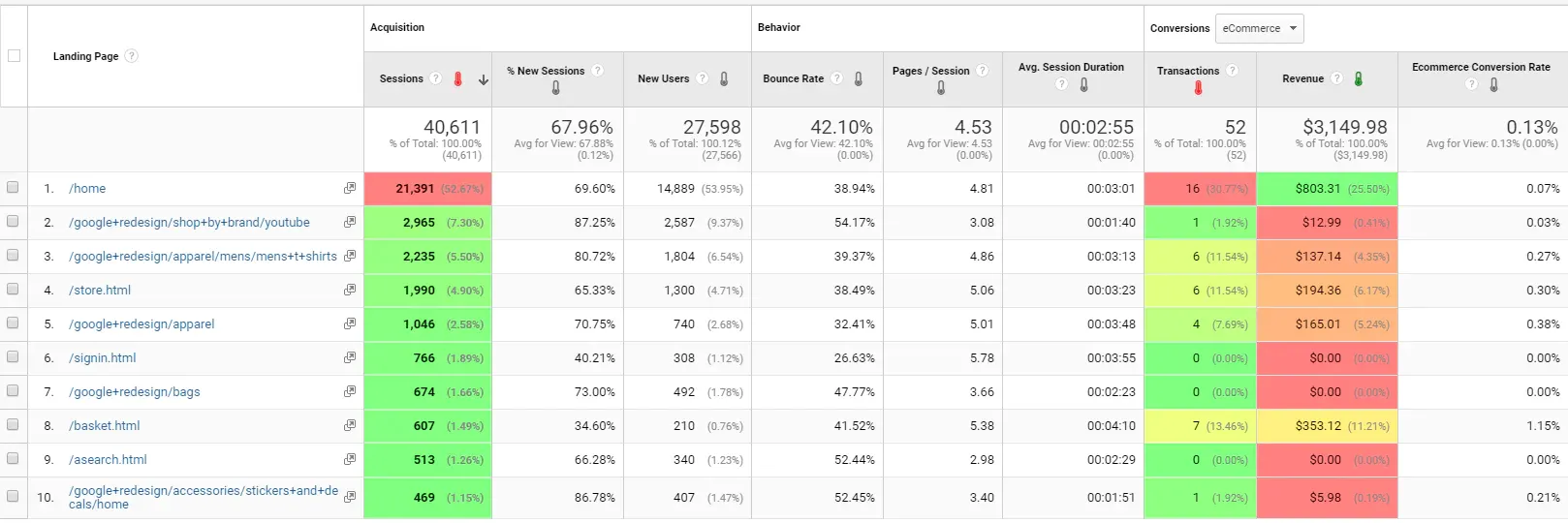
- Understanding how users interact with your website allows you to personalize emails based on their interests and behaviors.
- Use cookies and tracking pixels in conjunction with your website analytics platform to monitor user behavior. Ensure you comply with data protection regulations by obtaining consent from users.
Customer Feedback and Surveys: Send surveys or feedback forms to gather qualitative data directly from your subscribers.
- Direct feedback helps you understand your audience's needs and preferences, allowing for more targeted personalization.
- Use email campaigns to send out surveys. Offer incentives to increase participation rates, and use open-ended questions to gain deeper insights.
Integration with CRM and Sales Data: Sync your email marketing platform with your CRM or sales database to leverage existing customer data.
- Integrating these systems provides a holistic view of each customer, enhancing your ability to personalize emails based on comprehensive data.
- Choose email marketing software that offers integration options with your CRM system. Set up automated data syncs to keep your email list and segmentation up to date.
Personalize Your Content
Crafting content that feels tailor-made for the recipient can significantly increase engagement and conversion rates. Here’s how to personalize your email content effectively:
Use Personalized Subject Lines
Start with a subject line that captures attention by including the recipient's name or other personalized elements.
- Personalized subject lines can increase open rates by up to 26%, making them a critical first step in engaging the recipient.
- Use email marketing tools that allow you to insert personalized tokens (like the recipient’s name) directly into the subject line.

Improve the Email Body Content
Dive deeper into personalization by customizing the body of your email to align with the recipient's interests, previous interactions, and behavior.
Dynamic Product Recommendations: Based on the recipient’s browsing history or past purchases, recommend products or services that match their interests.
- This shows the recipient that you understand their needs, increasing the likelihood of conversion.
- Use data from your CRM or ecommerce platform to segment your audience based on interests and past behaviors, then tailor your content accordingly.
Personalized Stories or Messages: Share stories, testimonials, or messages that resonate with the specific interests or circumstances of the segment you’re targeting.
- Stories can create an emotional connection, making your emails more memorable and engaging.
- Collect customer success stories or create content that reflects common experiences or interests within each segment.
Customize Offers and Calls-to-Action (CTAs)
Make your offers and CTAs irresistible by personalizing them based on the data you’ve collected.
Special Discounts for Interests: Offer discounts on products or services that the recipient has shown interest in.
- Tailored offers feel more relevant and are more likely to motivate a purchase.
- Analyze purchase history and click-through data to identify which offers are most likely to appeal to each segment.
Personalized Event Invitations: For segments based on location, personalize invitations to events near them.
- Localized content increases the relevance and appeal of your emails.
- Use geographical data to segment your list and tailor event invitations or local store promotions.
Optimize Timing and Frequency

The timing and frequency of your emails can significantly influence their effectiveness. Personalizing these aspects based on subscriber preferences and behaviors ensures your messages arrive when they’re most likely to be welcomed and read.
Analyze Best Send Times: Use data analytics to identify when your subscribers are most likely to open and engage with emails. This can vary by segment.
- Tailoring send times to when subscribers are most active can lead to higher open and engagement rates.
- Most email marketing platforms provide insights into subscriber activity. Use this data to schedule emails for optimal engagement times.
Personalize Email Frequency: Not all subscribers will want to hear from you with the same frequency. Some prefer daily updates, while others might want weekly or monthly summaries.
- Adjusting the frequency to match subscriber preferences reduces the risk of unsubscribe rates due to email fatigue.
- Offer options at sign-up for email frequency and allow subscribers to adjust their preferences in the email footer.
Utilize Technology
Advanced email marketing technologies offer powerful tools for creating, sending, and managing personalized emails at scale. Leveraging these tools can significantly enhance the personalization of your campaigns.
Email Marketing Automation Platforms: Platforms like Mailchimp, HubSpot, and Salesforce provide features for automation, segmentation, and personalization.

- Automation tools can trigger personalized emails based on specific actions, such as a website visit or a shopping cart abandonment, making your messages timely and relevant.
- Set up automated workflows that send personalized emails based on subscriber behavior, such as welcome emails for new subscribers or follow-up emails after a purchase.
Dynamic Content Tools: These tools allow you to change parts of your email content based on the characteristics or behavior of each subscriber.
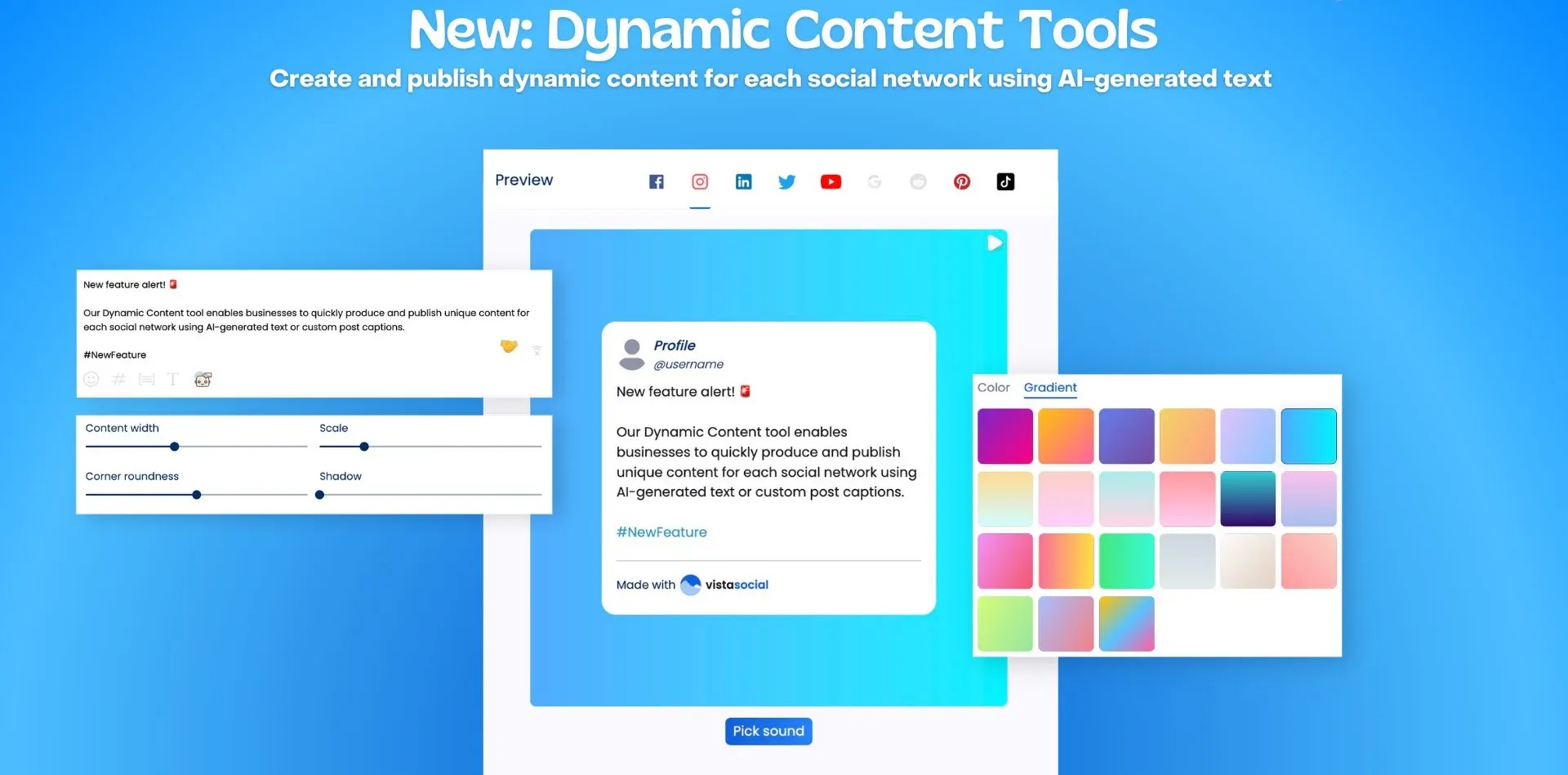
- Dynamic content makes each email feel custom-made, increasing the relevance and engagement of your messages.
- Use dynamic content for product recommendations, content curation, and personalized greetings. This requires integrating your email platform with your CRM or ecommerce system to leverage real-time data.
A/B Testing Capabilities: Testing different elements of your emails (such as subject lines, send times, and content personalization) helps you understand what works best for your audience.
- A/B testing provides data-driven insights into subscriber preferences, allowing you to refine your personalization strategies for better results.
- Most email marketing platforms offer A/B testing tools. Design tests for small segments of your audience before rolling out the winning variations to the broader list.
Engage with Personal Stories and Details
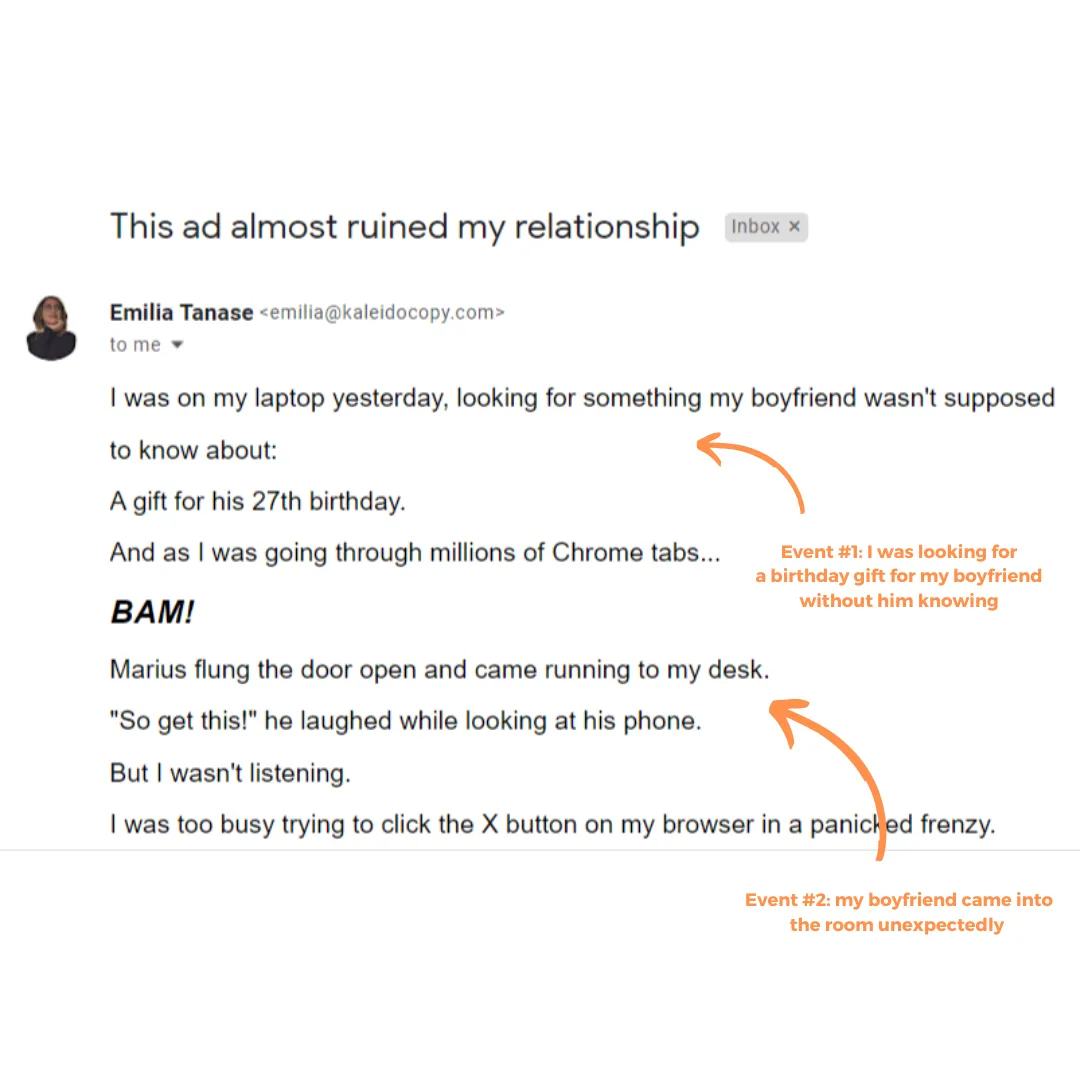
Personal stories and details make your emails more relatable and memorable, driving engagement and loyalty. Here’s how to effectively integrate this approach into your personalized email strategy:
Share Real Experiences: Include stories from your team, customers, or community that align with your brand values and resonate with your audience's interests or challenges.
- Stories evoke emotions and can make your brand more relatable. They help subscribers see the real people behind the brand, which can enhance trust and loyalty.
- Collect stories through interviews, customer feedback, or social media. Feature these stories in your emails where they naturally fit, such as in a section dedicated to customer success stories or a message from your CEO about overcoming personal challenges.
Detail Personal Achievements or Milestones: Celebrate personal milestones related to your brand or product, such as the anniversary of a subscriber’s first purchase or milestones in their user journey.
- Acknowledging personal milestones shows subscribers that you pay attention to their relationship with your brand, making them feel valued.
- Use data from your CRM to track subscriber milestones. Send personalized emails commemorating these occasions with special offers or messages of appreciation.
Use Personalized Visuals: Incorporate visuals that reflect the recipient's experiences with your brand, like images of products they’ve purchased or events they’ve attended.
- Personalized visuals can capture attention and enhance the personal connection by reminding subscribers of their interactions with your brand.
- Implement dynamic content in your emails that changes the imagery based on the subscriber's purchase history or engagement with your brand.
Personal Sign-Offs: End your emails with a personal sign-off from a company representative, adding a human touch to your communications.
- A personal sign-off can make emails feel more like a one-on-one conversation rather than a broad broadcast, reinforcing the personal connection.
- Choose a member of your team relevant to the email's content (such as a product expert for product-related emails) to sign off the message. This could also be a good opportunity for a brief message or personal note from them.
Measure and Optimize
Optimizing your personalized emails requires a cycle of measuring their performance and making data-driven adjustments. This approach ensures your strategies remain impactful and resonate well with your audience.
Track Key Performance Indicators (KPIs)
- Monitor Open and Click-Through Rates: These metrics reveal the engagement level of your emails, guiding you on the effectiveness of your personalized subject lines and content.
- Assess Conversion Rates: Understand how your emails contribute to your business goals by tracking actions taken by recipients.
Utilize A/B Testing
- Experiment with Email Elements: Test variations in subject lines, content, and send times to determine what maximizes engagement and conversions.
Gather Feedback
- Seek Subscriber Input: Incorporate surveys or encourage replies to gain insights beyond what analytics can provide, ensuring your emails meet subscriber expectations.
Implement Continuous Optimization
- Adjust Based on Insights: Use the data and feedback to refine your approach, including segmentation and personalization tactics, to enhance relevance and effectiveness.
9 Best Personalized Email Examples
1. Spotify

Why this email examples work
- Targeted approach: Acknowledges recipient's loyalty as a top listener on Spotify.
- Personal touch: Crafted to seem like it's from Charles Kelley of Lady Antebellum.
- Exclusivity: Offers early access to concert tickets.
- Urgency: Time-limited presale encourages quick action.
- Social sharing: Allows purchase of up to six tickets, promoting sharing with friends.
- Continued engagement: Introduces a new single to encourage ongoing interaction.
- Clear call to action: "BUY TICKETS HERE" button guides recipients towards the next step.
- Simplicity: Direct message minimizes confusion for a positive response.
2. Sephora
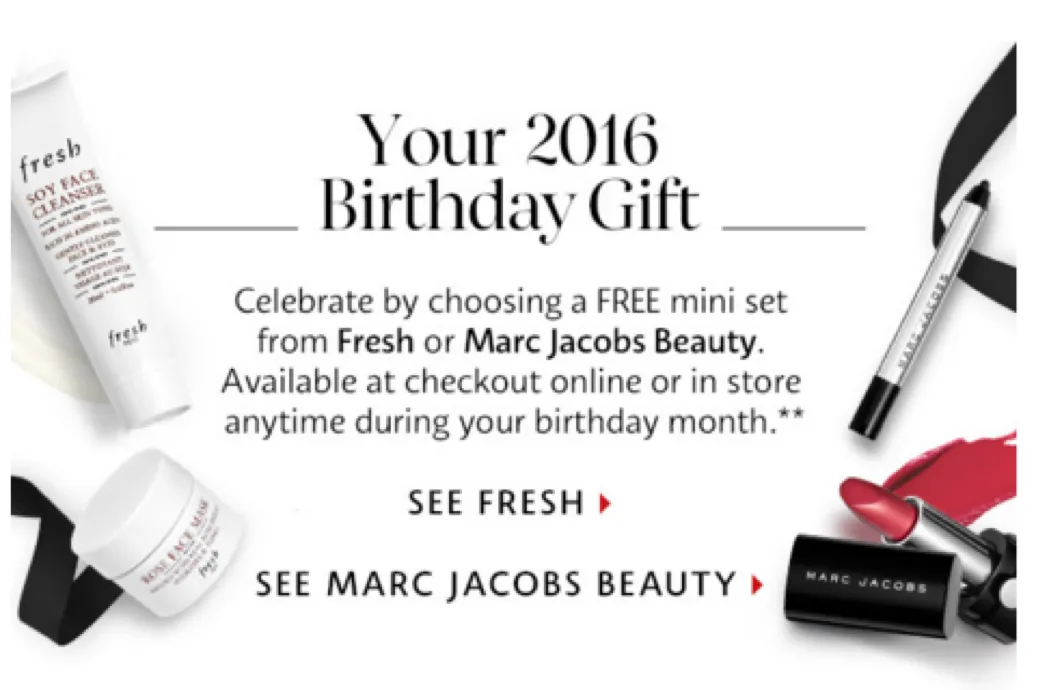
Why this email examples work
- Clear value proposition: Offers a birthday gift, creating an instant connection.
- Personal appeal: Recognizes the recipient's personal occasion.
- Choice and agency: Allows selection between free mini sets from Fresh or Marc Jacobs Beauty.
- Flexibility: Redeemable online or in-store during the birthday month for convenience.
- Visual enhancement: Showcases products to make the offer more attractive.
- Simple navigation: Clear call-to-action buttons ("SEE FRESH" and "SEE MARC JACOBS BEAUTY") for easy exploration.
- Personalized touch: Combines personalization with a generous offer to make recipients feel valued.
3. TikTok

Why this email examples work
- Capitalizes on social media engagement: Notifies recipient of new content from a user they follow, Gordon Ramsay.
- Leverages existing interest: Recipient follows Gordon Ramsay, indicating interest in his content.
- Encourages return to platform: Highlights number of new videos, prompting recipient to engage with TikTok app.
- Provides teaser: Includes snippet from one of the videos to pique curiosity.
- Incorporates social proof: Displays number of likes on the post, enticing recipient to join other viewers.
- Simple and direct messaging: Makes email compelling by combining social engagement elements.
4. Netflix

Why this email examples work
- Personalization: Addressed to recipient by name, "Jim," adding a personal touch.
- Re-engagement invitation: Invites Jim to "Enjoy Netflix again," indicating previous membership.
- User-centric message: Emphasizes Netflix's convenience and flexibility in watching content anytime, anywhere, on any device.
- Addressing pain points: Highlights uninterrupted viewing without commercials, addressing frustrations with traditional TV.
- Prominent call-to-action: "REJOIN TODAY" button conveys urgency and encourages immediate action.
- Visual reminders: Features Netflix logo and images from their content library to remind recipient of entertainment options.
- Transparency and trust: Provides clear information about terms and customer service contact details, enhancing trustworthiness.
- Effective combination: Personalization, clear value proposition, and direct call to action contribute to email's effectiveness in re-engaging recipients.
5. Ancestry
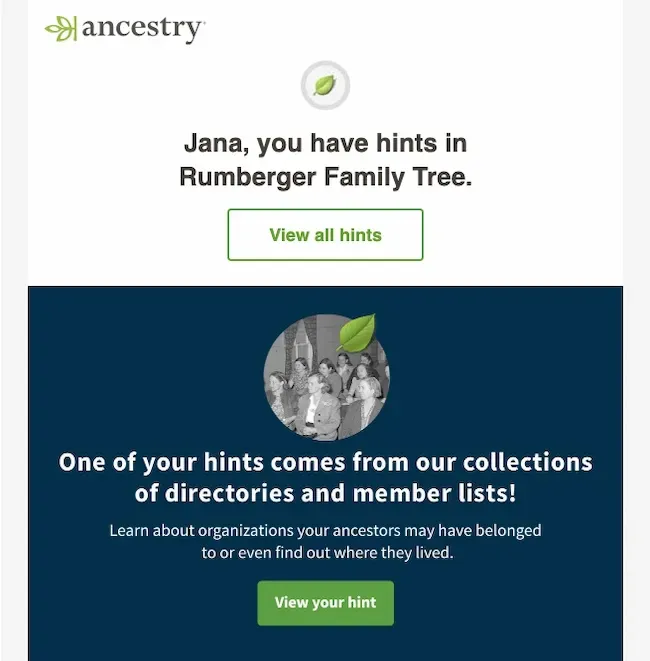
Why this email examples work:
- Highly personalized approach: Addresses recipient, Jana, by name for individualized feel.
- Tap into curiosity: Informs Jana of new "hints" in her Rumberger Family Tree, encouraging engagement.
- Clear call to action: "View all hints" button simplifies next steps for user engagement.
- Teases specific content: Implies hints could reveal meaningful information about her ancestors.
- Motivator for revisiting: Promise of discovering valuable family history encourages return to site.
- Clean design and concise message: Focuses recipient's attention on the call to action.
- Effective combination: Personalization, clear call to action, and intriguing content make email effective.
6. Google Maps
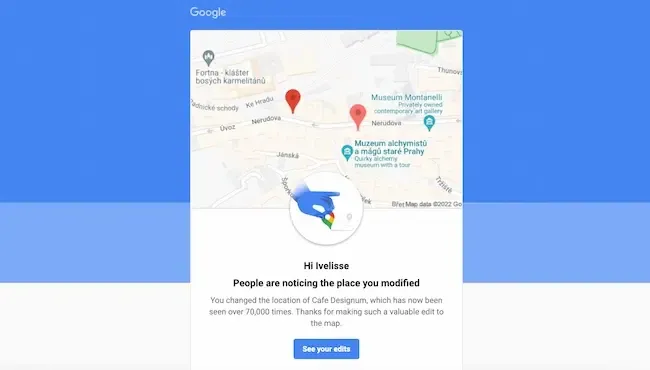
Why this email examples work:
- Personalized acknowledgment: Thanks "Ivelisse" for her specific contribution to Google Maps.
- Affirmation of impact: Recognizes the modification of Café Desigual's location, seen over 70,000 times, enhancing the value for other users.
- Encouragement for further engagement: Affirms the importance of her contribution, likely prompting continued participation.
- Visual reinforcement: Map with pin drop provides context and reminds her of her specific contribution.
- Clear call to action: "See your edits" button allows direct viewing of her contribution, fostering satisfaction and ownership.
- Reinforcement of positive behavior: Acknowledging helpfulness and visibility of contribution fosters a collaborative relationship between user and service.
7. Alex Mill
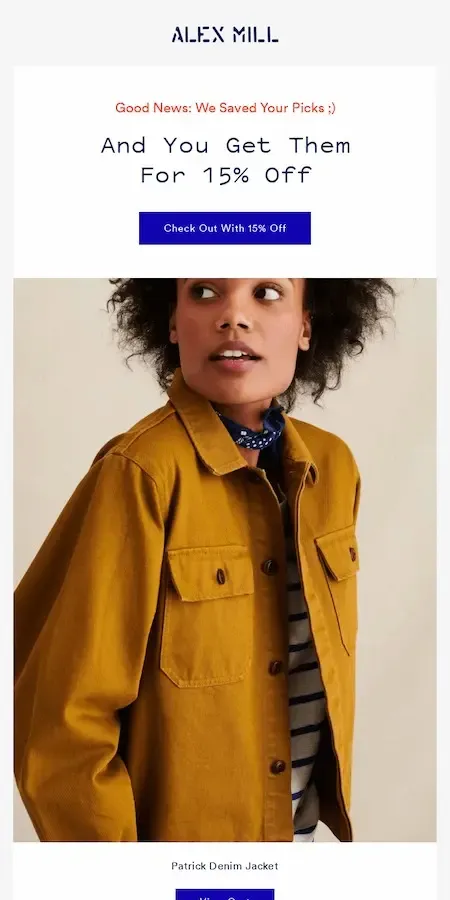
Why this email examples work:
- Personalized attention: "Good News: We Saved Your Picks ;)" suggests items of interest were noted, creating a personalized feel.
- Discount incentive: Offer of a 15% discount encourages purchase completion.
- Clear call to action: "Check Out With 15% Off" button provides direct guidance.
- Visual reminder: Featuring an image of a product (Patrick Denim Jacket) visually reminds the user of their interest.
- Effective combination: Personalized service, discount incentive, and clear call to action drive conversion.
8. We Miss Your Email
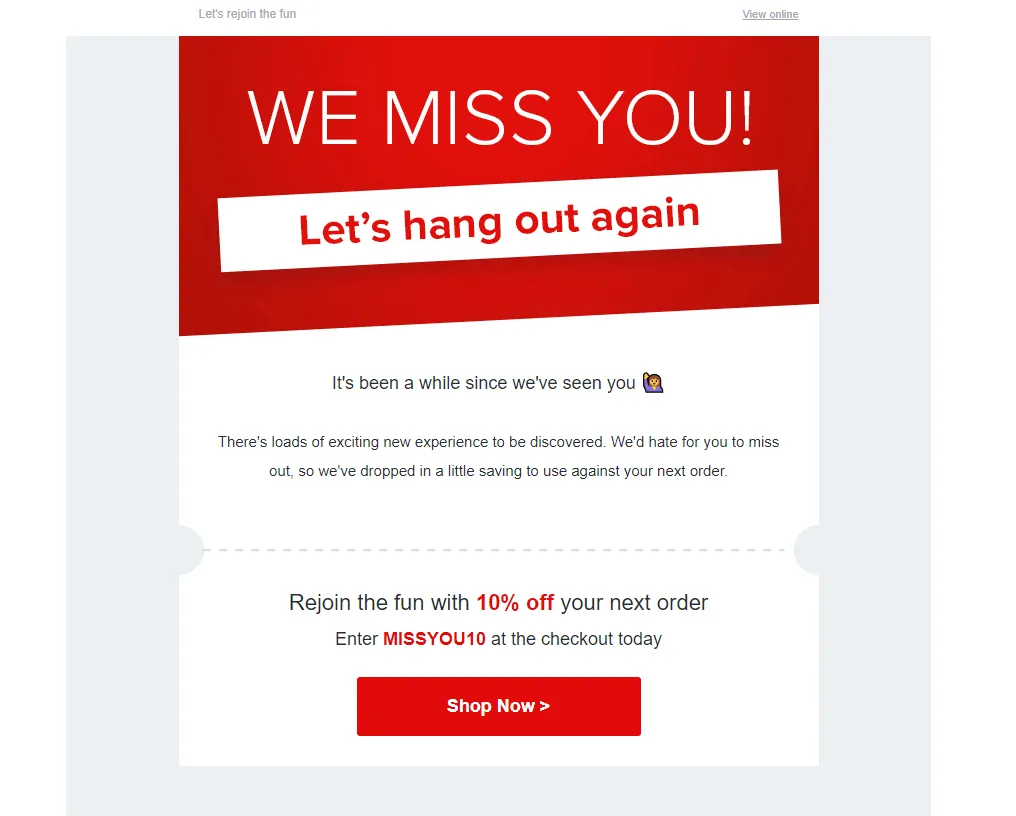
- Re-engagement goal: Aims to reconnect with a lapsed customer using a personal and conversational tone.
- Emotional appeal: Header "WE MISS YOU! Let's hang out again" conveys a sense of lost connection, appealing to emotions.
- Acknowledgment of absence: Message acknowledges recipient's absence and expresses a desire to reconnect, tailored to their situation.
- Highlighting new opportunities: Mention of "loads of exciting new experiences" suggests new offerings, reigniting interest.
- Discount incentive: Offers a 10% discount with personalized code "MISSYOU10" to motivate a return.
- Clear call to action: "Shop Now" button provides a straightforward path for the recipient to return to shopping.
- Strategic combination: Personal appeal, update on new offerings, and financial incentive work together to rekindle the customer-brand relationship.
9. Men's Health

- Personalization: Addressed directly to "Sarah," establishing an immediate connection.
- Subject line enhancement: "Sarah, unlock a special treat just for you" further enhances personalized approach, enticing her to open.
- Anticipation and curiosity: Promise of a "special treat" creates anticipation and curiosity.
- Urgency: Time-sensitive offer with "Hurry, offer ends soon" creates urgency, motivating quick action.
- Clear call-to-action: "Shop Now" button directs to desired action, simplifying the process.
- Value addition: Mention of free shipping adds value to the offer, making it more enticing.
- Effective combination: Personalization, urgency, and compelling incentive prompt engagement and potential purchase.
Email Personalization Strategies

1. Build a List You Can Segment

Building a list involves dividing your email list into smaller groups based on specific criteria such as demographics, behavior, purchase history, or engagement levels.
This enables you to tailor your messaging to meet the unique needs and interests of different audience segments.
- Increased Relevance: By segmenting your list, you can send emails that are more relevant to each subscriber. According to Mailchimp, segmented email campaigns have a 14.31% higher open rate than non-segmented campaigns.
- Higher Engagement: Targeted emails result in 100.95% higher click-through rates compared to non-segmented emails, making segmentation crucial for engagement.
- Better Conversion Rates: Personalized emails based on segmentation can lead to a significant increase in conversion rates, as they address the specific interests and needs of the audience.
How to Implement
Collect Comprehensive Data: Start with collecting as much relevant information as possible through sign-up forms, customer interactions, and behavior tracking.
- Use sign-up forms that capture essential information (like age, location, interests) without overwhelming new subscribers.
- Implement tools to track user behavior on your website, such as pages visited, items added to the cart, and purchase history.
Define Segmentation Criteria: Identify which criteria are most relevant to your business and audience. Common segmentation strategies include:
- Demographic Segmentation: Age, gender, location, and job title.
- Behavioral Segmentation: Purchase history, email engagement, and website behavior.
- Psychographic Segmentation: Interests, values, and lifestyle.
Use Email Marketing Tools: Leverage email marketing platforms that offer advanced segmentation capabilities.
- Select a platform that allows for dynamic segmentation, automatically updating segments as subscriber data changes.
- Utilize these tools to create automated email campaigns targeted at specific segments, ensuring each subscriber receives content tailored to their profile.
2. Aligning Emails with the Buyer's Journey

Understanding and aligning your email marketing efforts with the buyer's journey ensures that you deliver the right message at the right time. This strategy enhances the relevance of your communication, guiding potential customers through the sales funnel more effectively.
The buyer's journey refers to the process customers go through before making a purchase, typically divided into three stages: awareness, consideration, and decision. Tailoring your emails to fit each stage of this journey ensures that your content meets the current needs and interests of your subscribers
- Increased Engagement: Emails aligned with the specific stage of the buyer's journey are more likely to engage the reader, as they address the recipient's immediate needs or questions.
- Higher Conversion Rates: By providing relevant information at each stage, you gently guide potential customers towards making a purchase, effectively increasing conversion rates.
- Builds Trust and Loyalty: Showing that you understand where the customer is in their journey fosters trust and loyalty, making them more likely to choose your brand.
How to Implement
Identify the Stages of Your Buyer's Journey: Start by mapping out the buyer's journey for your product or service. Understand the questions, concerns, and decision-making criteria at each stage.
- Awareness Stage: Focus on educational content that addresses the problem your product or service solves.
- Consideration Stage: Provide comparisons, case studies, or detailed product information that helps subscribers evaluate their options.
- Decision Stage: Offer incentives, testimonials, or free trials to encourage purchase decisions.
Segment Your Audience Based on Journey Stage: Use subscriber behavior and interaction data to segment your email list according to where each subscriber is in the buyer's journey.
- Implement tracking on your website to identify how users interact with your content, which can indicate their stage in the journey.
- Use email engagement metrics (e.g., which emails they open and what content they click on) to further refine these segments.
Create Targeted Email Content for Each Stage: Develop email content specifically designed to address the needs and interests of subscribers at each stage of the buyer's journey.
- Awareness Emails: Educate your audience with blog posts, ebooks, or industry reports that address the initial problem or need.
- Consideration Emails: Highlight features, benefits, and differentiators of your products/services through comparison guides, webinars, or customer stories.
- Decision Emails: Encourage the final purchase with special offers, product demos, or money-back guarantees.
3. Crafting Emails with a Personal Touch
This approach involves using layout, content, and visual elements in a way that resonates personally with the audience, enhancing engagement and fostering a deeper connection.
Email design personalization involves tailoring the visual and content elements of your emails based on the preferences, behaviors, and data of your subscribers.
This can include dynamic content, personalized images, and customized layouts that reflect the recipient's previous interactions with your brand.
- Increase Engagement: Personalized email designs have a higher likelihood of capturing the recipient's attention, leading to increased open and click-through rates.
- Enhances Relevance: By aligning the design and content with the recipient's interests and behaviors, you make the email more relevant and valuable, which can significantly improve conversion rates.
- Strengthens Brand Connection: Personalized design elements make subscribers feel recognized and valued by the brand, deepening their emotional connection and loyalty.
How to Implement
Leverage Subscriber Data for Design Choices: Use the data you have on your subscribers to influence design decisions, ensuring that every element of the email speaks directly to their preferences and behaviors.
- Dynamic Content Blocks: Incorporate dynamic content that changes based on the subscriber's data, such as product recommendations based on past purchases.
- Personalized Visuals: Use visuals and imagery that reflect the subscriber's preferences, location, or previous interactions with your brand.
Design for Personalization from the Start: When creating your email templates, build them with personalization in mind. Ensure that your design allows for easy integration of personalized elements.
- Template Flexibility: Create email templates that are flexible enough to accommodate different types of personalized content and visuals.
- Mobile Responsiveness: Ensure that your personalized designs render beautifully across all devices, considering that a significant portion of emails are opened on mobile.
4. Simplify Next Steps in Personalized Emails
This strategy involves designing your emails in a way that the recipient intuitively knows what action they are expected to take next, whether it's making a purchase, signing up for a webinar, or simply learning more about a topic.
Clarity and ease in this context reduce friction, significantly increasing the likelihood of the recipient taking the desired action.
- Enhances User Experience: Clear, straightforward calls-to-action (CTAs) contribute to a better overall experience for the recipient, making them more likely to engage.
- Increases Conversion Rates: By simplifying the decision-making process, you're effectively guiding subscribers through the sales funnel, leading to higher conversion rates. According to HubSpot, emails with a single CTA can increase clicks by 371% and sales by 1617%.
- Reduces Decision Fatigue: Too many options or unclear instructions can overwhelm recipients, leading to inaction. Streamlining the next steps combats this issue.
How to Implement
Define a Single Clear Objective for Each Email: Before drafting your email, decide on the one action you want the recipient to take. This focus will guide the design and content of your email.
- A singular focus prevents confusion and makes it easier for recipients to understand what’s expected of them.
- If the goal is to drive product purchases, ensure that the email content is curated around this objective, from product highlights to the final CTA.
Use Direct, Actionable Language in Your CTAs: Your call-to-action should be straightforward, indicating exactly what the recipient will get by clicking. Personalize your CTA based on the recipient's previous interactions with your brand for added relevance.
- Personalized CTAs perform 202% better than generic ones (HubSpot), likely because they resonate more with the individual’s interests and needs.
- If a segment of your audience frequently purchases a certain type of product, tailor CTAs in emails to that segment around similar product categories.
Design for Visibility: Ensure that your CTA buttons are prominently placed and visually distinct from the rest of the email content. Use colors that stand out but still fit within your brand’s design scheme.
- A CTA that catches the eye is more likely to be clicked.
- Place a brightly colored CTA button above the fold and again at the end of the email to catch both quick scanners and thorough readers.
Simplify the Process: The journey from clicking the CTA to completing the desired action should be as frictionless as possible. Minimize the number of steps required to complete the action.
- Each additional step in the process is an opportunity for the recipient to drop off. A simplified process keeps momentum and leads to higher conversion rates.
- If the goal is a purchase, direct the recipient to a landing page where they can buy the highlighted product in just a few clicks.
Email Marketing Platform for Personalized Email Campaigns
Selecting the right email marketing platform is crucial for conducting personalized email campaigns effectively. The ideal platform should offer advanced segmentation, automation capabilities, and robust analytics.
Key Features for Personalized Email Marketing Strategy
Advanced Segmentation: Ability to create detailed segments based on demographics, behavior, purchase history, and more. This enables you to tailor your messaging to specific audience groups.
Dynamic Content: The platform should allow for dynamic content insertion, where parts of the email content change based on the recipient's segment, ensuring a higher degree of personalization.
Automation and Workflow Tools: Look for platforms that offer sophisticated automation tools. These should let you trigger email sequences based on actions (like website visits, email opens, etc.), making your campaigns more relevant and timely.
A/B Testing: To refine your emails for higher performance, the platform should offer comprehensive A/B testing tools, allowing you to test different subject lines, content, and calls to action.
Integration Capabilities: The platform should easily integrate with your CRM, analytics tools, and other software to leverage existing customer data for personalization.
Reporting and Analytics: Detailed reporting tools to track open rates, click-through rates, conversion rates, and more, to continuously optimize your campaigns.
Personalized Email Marketing Tools
1. Mailchimp
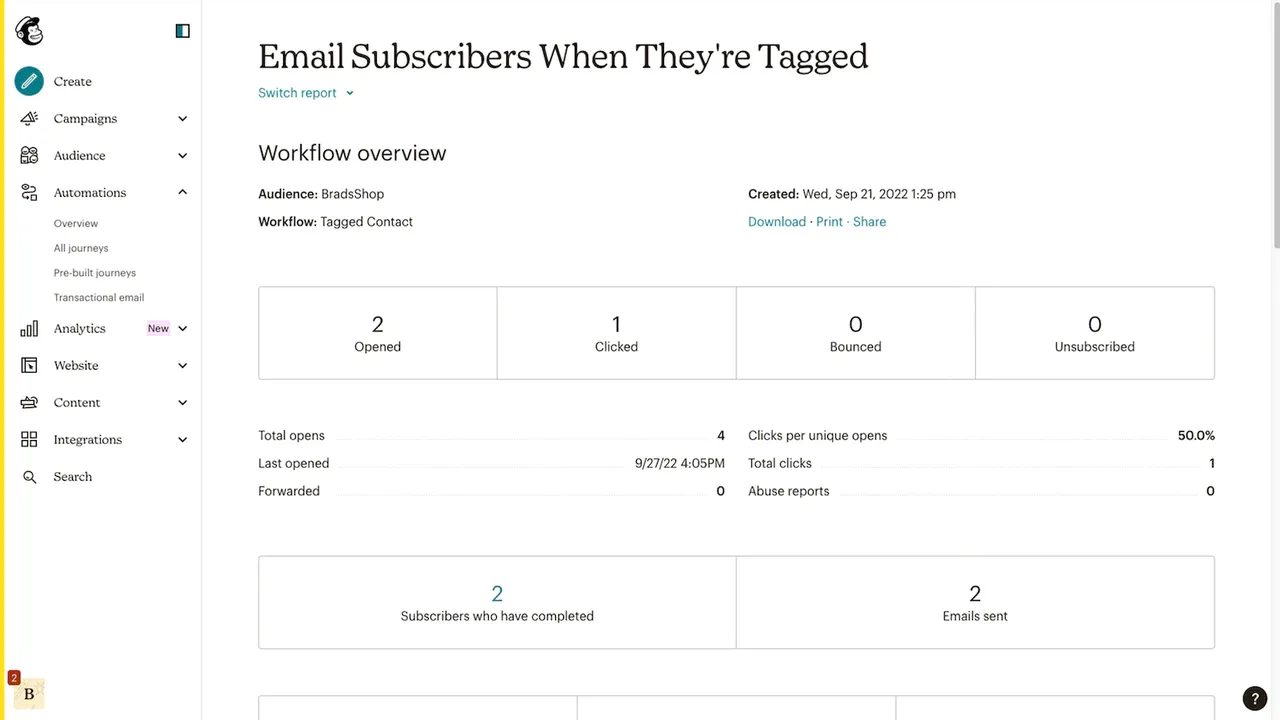
Known for its user-friendly interface, Mailchimp offers extensive automation capabilities, detailed segmentation options, and robust analytics. It’s suitable for businesses of all sizes, making it a popular choice for those starting with email marketing.
2. HubSpot
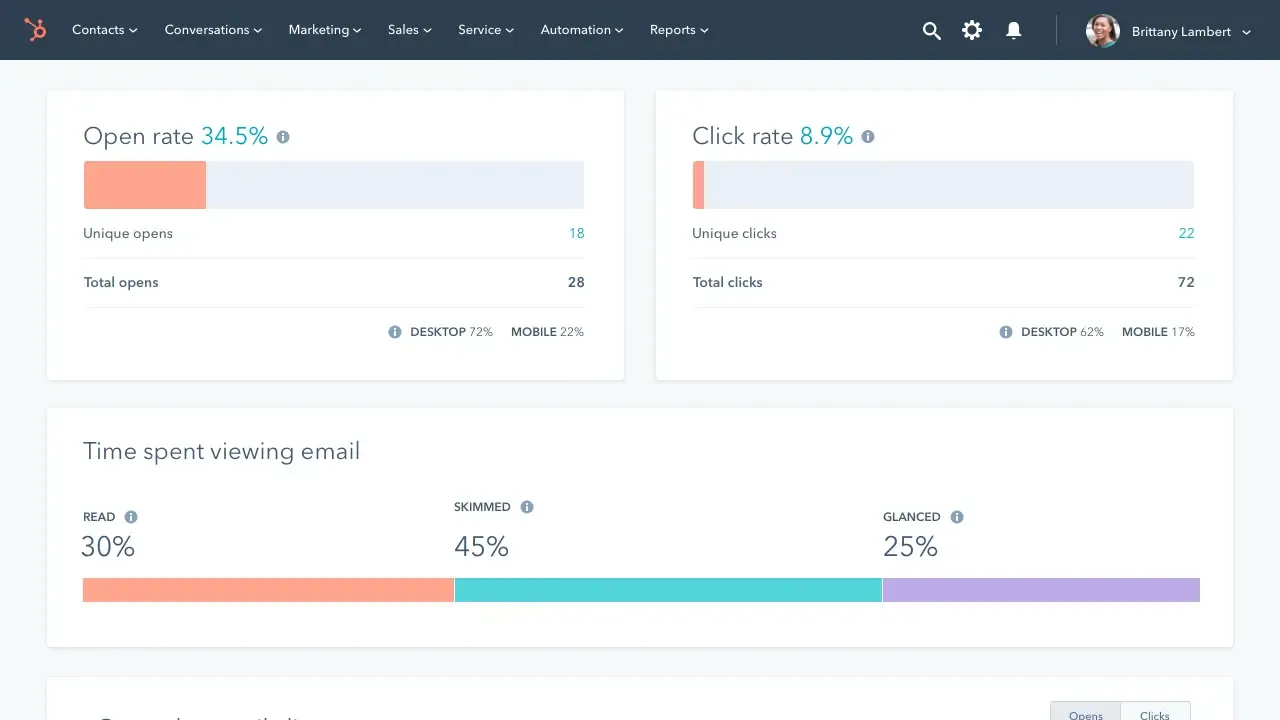
Offers a comprehensive suite of tools beyond email marketing, including CRM and sales tools, which can deeply integrate for highly personalized campaigns. Its strength lies in workflow automation and detailed performance analytics.
3. ActiveCampaign
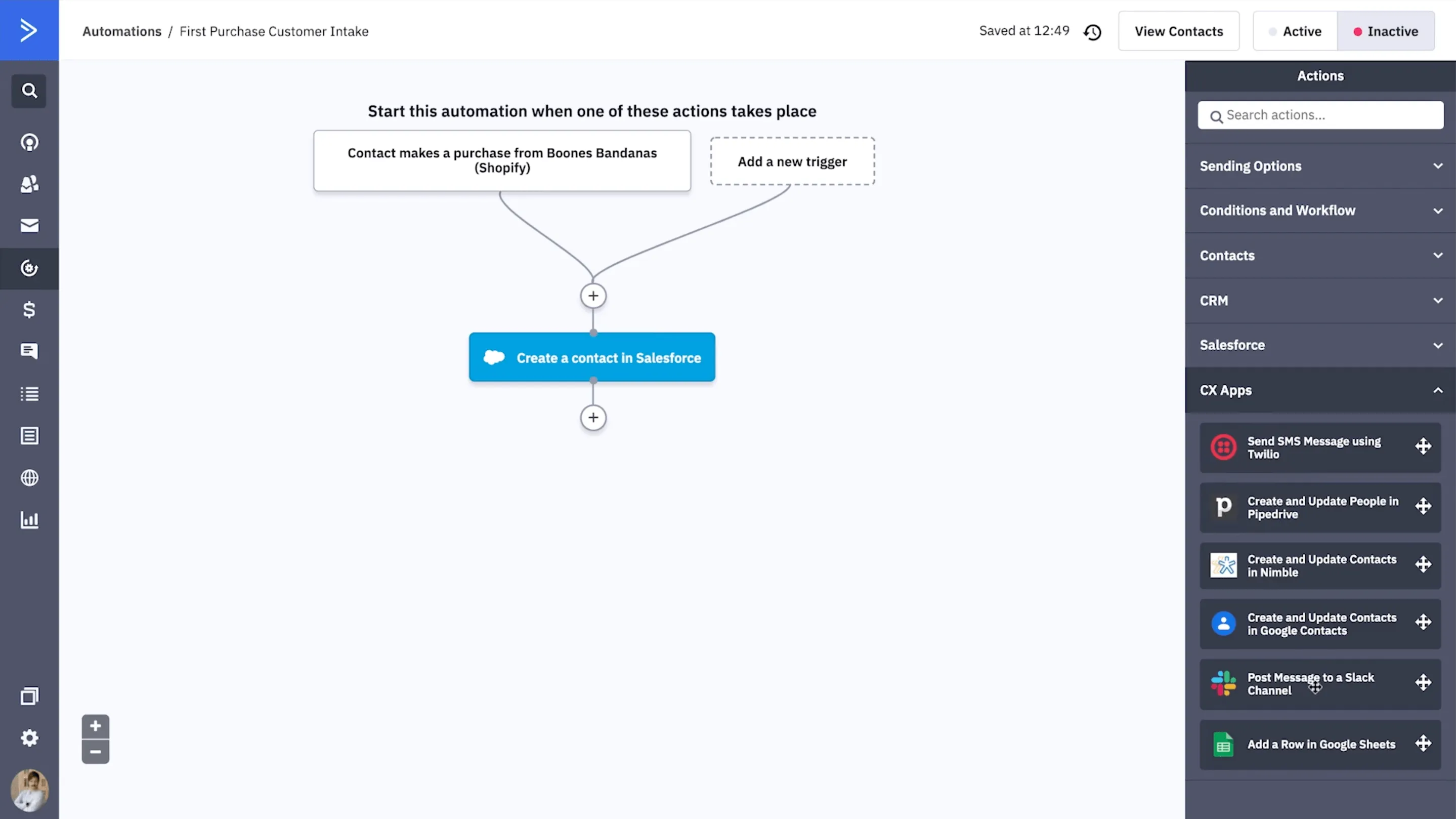
Focuses on advanced email automation and segmentation. It’s particularly strong in triggering emails based on site tracking and behavior, making it ideal for personalized campaigns.
4. ConvertKit

Preferred by creators and small businesses, ConvertKit offers simple yet powerful automation and segmentation tools, designed for ease of use without compromising on personalization capabilities.
5. Klaviyo
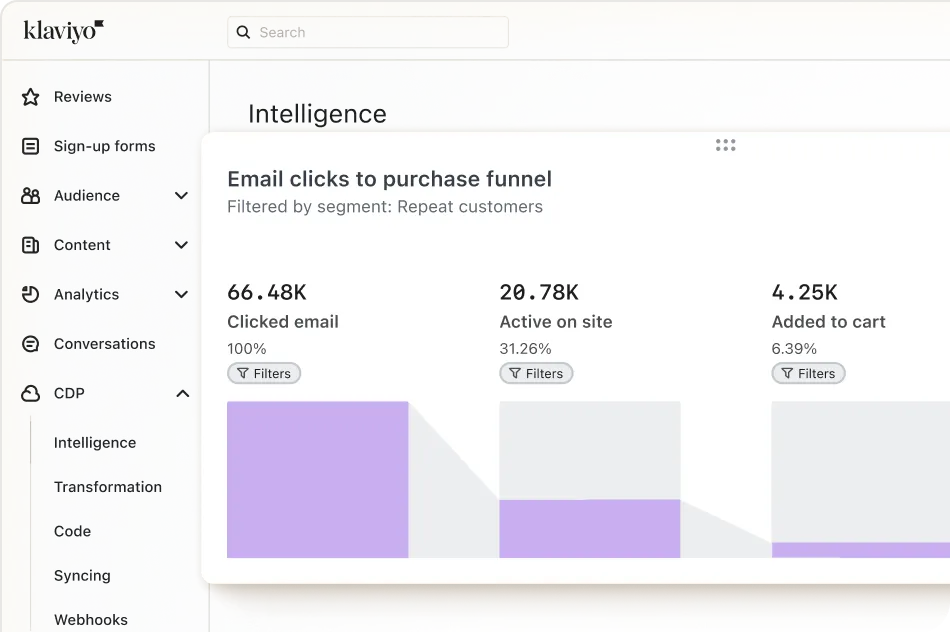
Best for e-commerce businesses, Klaviyo excels in leveraging transactional data for personalized campaigns. It integrates deeply with e-commerce platforms like Shopify, allowing for targeted campaigns based on purchase behavior, becoming a preferred email marketing tool for sales or marketing team.
Common Mistakes in Personalized Email Marketing and How to Avoid Them
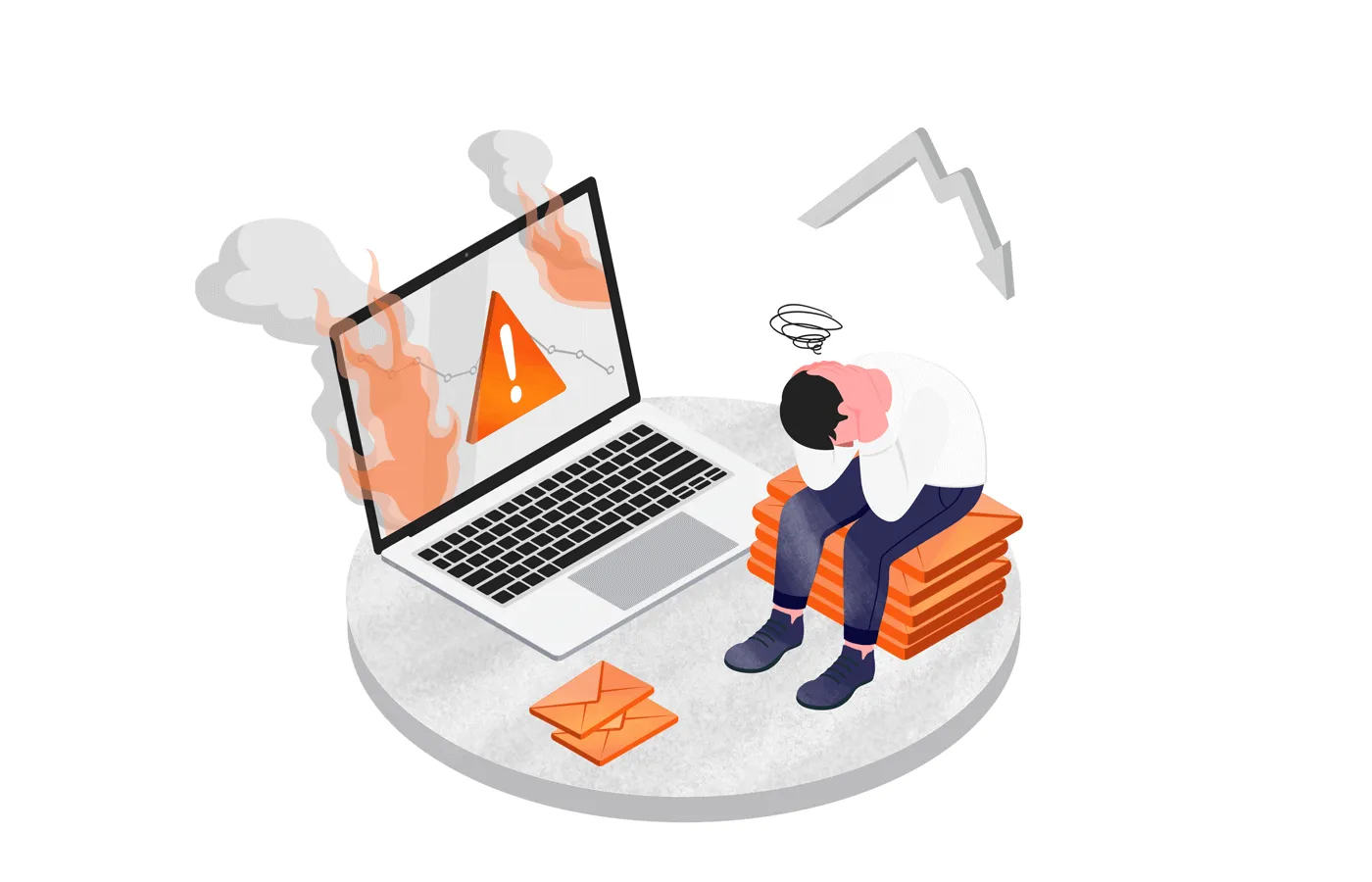
Understanding these mistakes is crucial for crafting effective and engaging personalized email campaigns. Let's dive into some of these common errors and outline strategies for avoiding them.
1. Over-reliance on Basic Personalization Techniques
Simply inserting a recipient's name into an email doesn't cut it anymore. Consumers expect deeper levels of personalization that reflect their preferences, behaviors, and past interactions with your brand.
How to Avoid: Leverage advanced segmentation and dynamic content to create more nuanced and relevant email experiences. Utilize data like purchase history, browsing behavior, and engagement patterns to tailor your messaging and offers.
2. Ignoring the Customer Journey
Not all subscribers are at the same stage of the customer journey. Sending the same message to someone who just discovered your brand as you would to a loyal customer can lead to disengagement.
How to Avoid: Map out your customer journey and create content tailored to each stage. Use segmentation and automation to deliver the right message at the right time, nurturing leads and guiding them towards conversion.
3. Neglecting Email Testing
Assuming what works for one segment will work for all can be a costly mistake. Without testing, you're missing out on optimizing your emails for higher performance.
How to Avoid: Implement A/B testing for various elements of your emails, including subject lines, call-to-actions, and content layout. Use the insights gained to refine your approach and improve the effectiveness of your personalized email campaign.
4. Poor Data Quality
The success of personalized marketing hinges on the quality of your data. Outdated, incorrect, or incomplete data can lead to irrelevant personalization that might annoy your subscribers.
How to Avoid: Regularly clean and update your email list to remove inactive subscribers and correct inaccuracies. Implement double opt-in procedures to ensure that the data you collect is accurate from the outset.
5. Not Respecting Privacy
With increasing concerns about data privacy, it's crucial to use personalization in a way that respects your subscribers' privacy and adheres to regulations like GDPR.
How to Avoid: Always obtain explicit consent before collecting and using personal data. Be transparent about how you use this data in your marketing efforts and provide subscribers with easy options to manage their preferences and opt-out.
Final Thoughts on Email Personalization
To sum up, email marketing personalization is important as it leads to higher engagement, sales, and customer loyalty. Key steps include knowing your audience, leveraging technology, and continuously improving your campaigns based on data.
Avoid basic mistakes like minimal personalization, treating all subscribers the same, and neglecting data quality and privacy.
Focus on deep personalization to make your emails resonate. Implement the strategies outlined here to send targeted messages that build lasting customer relationships. Personalization is essential for any brand looking to stand out and sustain growth.

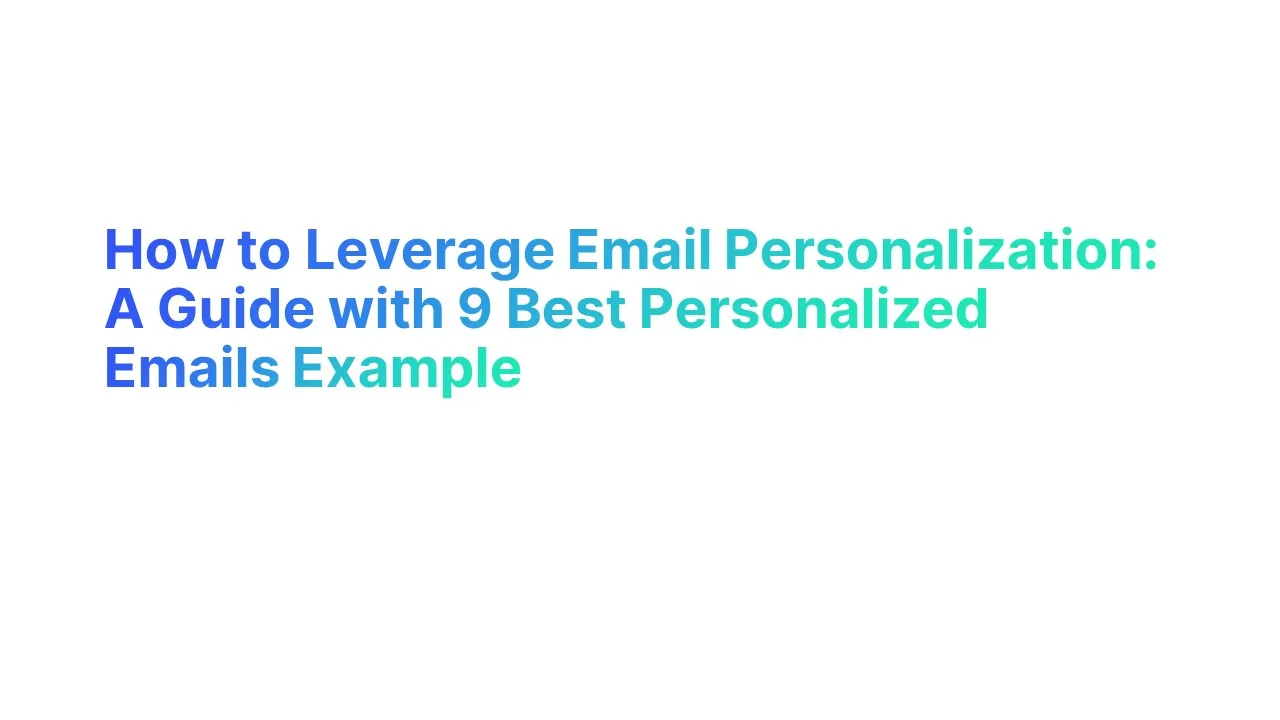



.png)

